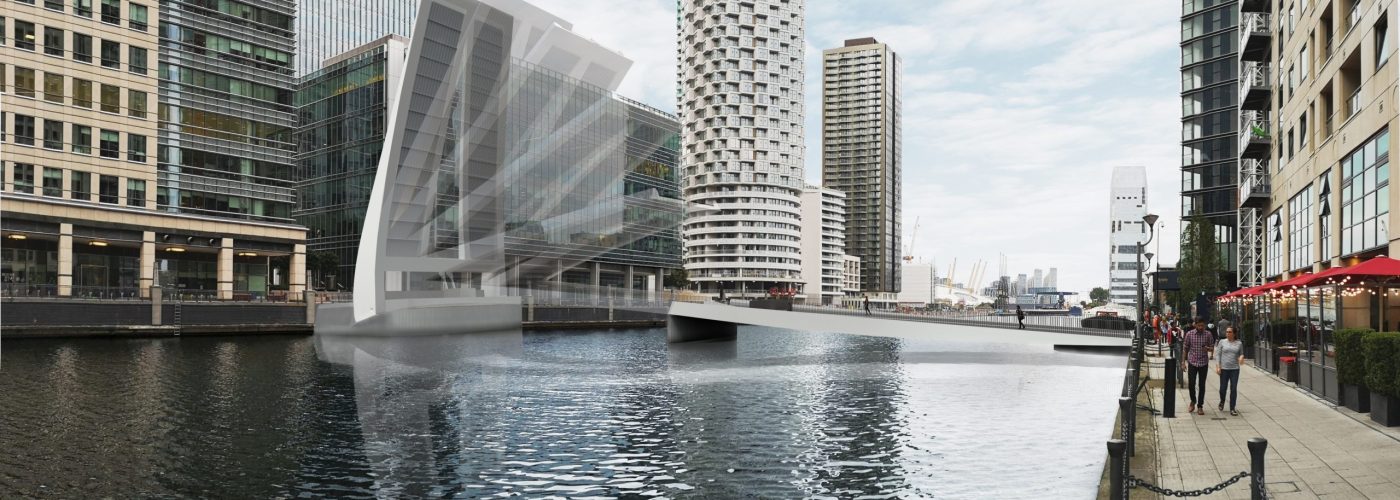South Dock Bridge, a new pedestrian bridge in London’s Docklands, has received substantial public backing at recent consultation. Designed by Knight Architects, Arcadis, and Kgal for the London Borough of Tower Hamlets (LBTH), the proposed bridge will support increased volumes of pedestrian traffic which are predicted with the expansion of the Isle of Dogs. Once completed, it is expected to become one of the busiest pedestrian bridges in London.
The Isle of Dogs in east London has been a major trading centre beside the River Thames for almost two hundred years, with Canary Wharf – one of the UK’s main financial centres – located here since 1980. The South Dock is one of two surviving docks and acts as a boundary between Canary Wharf and South Quay. The large volume of new development on the Isle of Dogs will increase predicted pedestrian traffic above levels that can be comfortably accommodated with existing infrastructure and the new pedestrian bridge has been proposed to support this expansion.
The new bridge will improve walkable connections between existing public open spaces, like Jubilee Park, with proposed development in the area and local public transport interchanges such as the new Elizabeth line station (Crossrail) and the South Quay DLR station. It is also anticipated to improve access to jobs, retail, and other services at Canary Wharf.
Following feedback from the RIBA Stage 2 Public Consultation (in 2018), a six-week second Public Consultation was held on the developed design for South Dock Bridge, between August and October 2020. The purpose of this new consultation, led by Knight Architects in close collaboration with LBTH, was to present the new design of the bridge and how it responded to the feedback from the previous consultation, before submitting a planning application. The consultation, to guarantee everyone interested would have the opportunity to provide their feedback during the Covid-19 pandemic, combined online events, public exhibitions and a specifically created website.
The new design painstakingly builds on the feedback received in the Stage 2 consultation, which sought for a bridge that was elegant, unobtrusive, contemporary, with a neutral finish, and that somehow responded to the industrial heritage of the area. The proposed bridge has been excellently received and supported by a clear majority of the respondents who praised the bridge design and felt their earlier feedback had been addressed and responded to.
The bridge has been designed as a sculpted two-span variable-depth steel beam with a single central pier in the dock. Each of these spans is approximately 35m long. The bridge provides a permanent 15m-wide and 3m-high navigable channel for smaller boats to pass underneath and, thanks to a movable (bascule) north span, a 25m wide channel without height restriction for taller ships. The deck width varies from 7.8m at the south end to 15.4m at the north one. A triangular void in the movable span directs people away from an existing emergency staircase serving the buildings located on axis at the north end of the crossing. The north abutment hosts the drive mechanism and a concealed counterweight that balances the structure to minimise the energy needed to open the bridge.
The design is slender, understated, and visually compact. The void created on the main span deck not only guides users and provides an enjoyable crossing experience, but makes the structure more transparent, distinctive and memorable, allowing views through the deck when the bridge is raised. Paying tribute to the history of Canary Wharf, the bridge’s sculptural geometry echoes the curved base of the historic cranes that were once sited along the quays when the site was a commercial port.
The main aspirations for the new bridge are for it to improve inclusive transport to support sustainable growth in the Isle of Dogs, contribute to local placemaking and provide a striking, elegant landmark in the area. The planning application has been submitted, and a decision is expected this month. The bridge is expected to start on site in 2022 and open in 2023.





